| 1 |
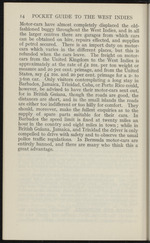 |
“...though the roads are good, the
distances are short, and in the small islands the roads
are either tod indifferent or too hilly for comfort. They
should, moreover, make the fullest enquiries as to the
supply of spare parts suitable for their cars. In
Barbados the speed limit is fixed at twenty miles an
hour in the country and eight miles in town; while in
British Guiana, Jamaica, and Trinidad the driver is only
compelled to drive with safety and to observe the usual
police traffic regulations. In Bermuda motor-cars are
entirely .banned, and there are many who think this a
great advantage....”
|
|
| 2 |
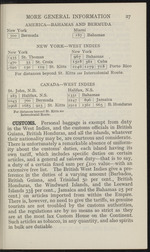 |
“...MORE GENERAL INFORMATION 27
AMERICA—BAHAMAS AND BERMUDA
New York Miami
J 700 I Bermuda | 187 | Bahamas
New York
NEW YORK—WEST INDIES
New York
Bahamas
Cuba
1435 St. Thomas 967 1528 2246
'*'479 35 St. Croix
£020 150 119 | St. Kitts
1279
718 I Porto Rico
For distances beyond St. Kitts see Intercolonial Route.
St. John, N.B.
CANADA—WEST INDIES
Halifax, N.S.
Bahamas
Jamaica
665" “
283 Halifax, N.S. 135*
1043 760 Bermuda 2247
1968 1685 925 | St. Kitts 2912
896
1561
B. Honduras
For distances beyond St. Kitts see
Intercolonial Route.
CUSTOMS. Personal baggage is exempt from duty
in the West Indies, and the customs officials in British
Guiana, British Honduras, and all the islands, whatever
their nationality may be, are courteous and considerate.
There is unfortunately a remarkable absence of uniform-
ity about the customs’ duties, each island having its
own tariff, which includes specific duties on certain
articles, and a general ad valorem duty—that is to say,
a duty of a certain fixed sum...”
|
|
| 3 |
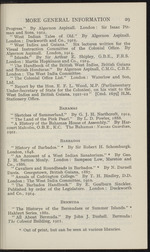 |
“...An Account of a West Indian Sanatorium.” * By Geo.
J. H. Sutton Moxly. London : Sampson Low, Marston and
Co., 1886.
“ Cavaliers and Roundheads in Barbados.” * By N. Darnell
Davis. Georgetown, British Guiana, 1887.
“ Annals of Codrington College.” By T. H. Bindley, D.D.
London : The West India Committee, 1910.
" The Barbados Handbook.” By E. Goulburn Sinckler.
Published by order of the Legislature. London : Duckworth
and Co., 1914.
Bermuda
" The Historye of the Bermudaes or Summer Islands.” *
Hakluyt Series, 1882.
'• All About Bermuda.” By John J. Bushell. Bermuda:
The Colonist Building, 1911.
* Out of print, but can be seen at various libraries....”
|
|
| 4 |
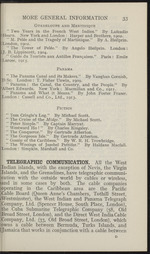 |
“...telegraphic communi-
cation with the outside world by cables or wireless,
land in some cases by both. The cable companies
operating in the Caribbean area are the Pacific
Cable Board (Queen Anne’s Chambers, Tothill Street,
Westminster), the West Indian and Panama Telegraph
Company, Ltd. (Spencer House, South Place, London),
;the Cuba Submarine Telegraphic Company (58, Old
Broad Street, London), and the Direct West India Cable
(Company, Ltd. (33, Old Broad Street, London), which
pwns a cable between Bermuda, Turks Islands, and
[Jamaica that works in conjunction with a cable between...”
|
|
| 5 |
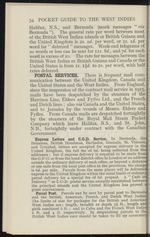 |
“...34 POCKET GUIDE TO THE WEST INDIES
Halifax, N.S., and Bermuda (mark messages “ via
Bermuda The general rate per word between most
of the British West Indian islands or British Guiana and
the United Kingdom is 2S. 2d. per Word, or is. id. per
word for “ deferred ” messages. Week-end telegrams of
20 words or less can be sent for Iis. 8d., and 7d. for each
word in excess of 20. The rate for messages between the
British West Indies or British Guiana and Canada or the
United States is from is. 1 \d. to 2S. per word, with half
rates deferred.
POSTAL SERVICES. There is frequent mail com-
munication between the United Kingdom, Canada and
the United States and the West Indies. From England,
since the suspension of the contract mail service in 1915,
mails have been despatched by the steamers of the
Harrison Line, Elders and Fyffes Ltd., and the French
and Dutch lines ; also via Canada and the United States,
and to Jamaica by the vessels of Messrs. Elders and
Fyffes. From Canada mails are despatched...”
|
|
| 6 |
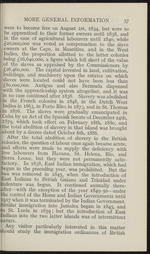 |
“... labourers until 1840, while
1 £20,000,000 was voted as compensation to the slave
I owners at the Cape, in Mauritius, and in the West
I Indies, the proportion allotted to the latter colonies
I being £16,640,000, a figure which fell short of the value
I of the slaves as appraised by the Commissioners by
I £26,460,000. The capital invested in land, cultivation,
■buildings, and machinery upon the estates on which
[slaves were located could not have been less than
[£80,000,000. Antigua and also Bermuda dispensed
jwith the apprenticeship system altogether, and it was
fin no case continued after 1838. Slavery was abolished
jin the French colonies in 1848, in the Dutch West
Undies in 1863, in Porto Rico in 1873, and in St. Thomas
Sin 1876. The slaves were gradually emancipated in
ICuba by an Act of the Spanish Senate of December 24th,
;i879> which took effect on February 18th, 1880, and
[the total abolition of slavery in that island was brought
(about by a decree dated October 6th, 1886.
I After...”
|
|
| 7 |
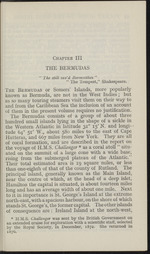 |
“...Chapter III
THE BERMUDAS
" The still vex’d Bermoothes ”
" The Tempest,” Shakespeare.
The Bermudas or Somers’ Islands, more popularly
known as Bermuda, are not in the West Indies; but
as so many touring steamers visit them on their way to
and from the Caribbean Sea the inclusion of an account
of them in the present volume requires no justification.
The Bermudas consists of a group of about three
hundred small islands lying in the shape of a sickle in
the Western Atlantic in latitude 3a0 15' N. and longi- <
tude 64° 51' W.f about 580 miles to the east of Cape
Hatteras, and 667 miles from New York. They are all
of coral formation, and are described in the report on
the voyage of H.M.S. Challenger * as a coral atoll “ situ-
ated on the summit of a large cone with a wide base,
rising from the submerged plateau of the Atlantic.”
Their total estimated area is 19 square miles, or less
than one-eighth of that of the county of Rutland. The
principal island, generally known as the Main Island,
near...”
|
|
| 8 |
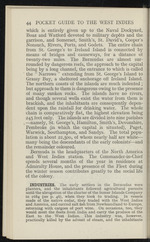 |
“...the inhabitants are consequently depen-
dent upon the rainfall for drinking water. The whole
chain is comparatively flat, the highest elevation being
245 feet only. The islands are divided into nine parishes
—namely, St. George’s, Hamilton, Smith’s, Devonshire,
Pembroke (in which the capital is situated), Paget,
Warwick, Southampton, and Sandys. The total popu-
lation is about 22,500, of whom nearly half axe white-
many being the descendants of the early colonists1—and
the remainder coloured.
Bermuda is the headquarters of the North America
and West Indies station. The Commander-in-Chief
spends several months of the year in residence at
Admiralty House, and the presence of the Fleet during
the winter season contributes greatly to the social life
of the colony.
INDUSTRIES. The early settlers in the Bermudas were
planters, and the inhabitants followed agricultural pursuits
until the abrogation of the charter of the Somer Islands Company
in 1684 {see p. 46), when they took to trading. In vessels...”
|
|
| 9 |
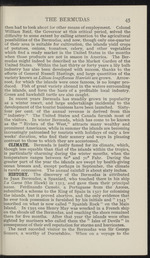 |
“...variety abound in the waters surrounding
I the islands, and form the basis of a profitable local industry.
I Green and hawksbill turtle are also caught.
In recent years Bermuda has steadily grown in popularity
I as a winter resort, and large undertakings incidental to the
I development of the tourist business have been launched. Sixty-
I four per cent, of the annual revenue is derived from tins
I r industry.” The United States and Canada furnish most of
I the visitors. In winter Bermuda, which has come to be known
I as the “ Riviera of the West,” attracts many wealthy and
I prominent Americans, while in summer the islands are becoming
I increasingly patronised by tourists with holidays of only a few
I weeks’ duration, who find their scenery and ways in pleasing
I contrast to those to which they are accustomed.
CLIMATE. Bermuda is justly famed for its climate, which,
I though less equable than that of the islands within the tropics,
[is particularly charming during the winter months, when the...”
|
|
| 10 |
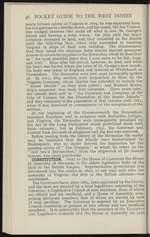 |
“...colonies; but in February, 1652, the Governor and
Council took the oath of allegiance and the ban was removed.
Before passing from the history of the Bermudas the reader
may be reminded that the islands were immortalised by
Shakespeare, who no doubt derived his inspiration for the
opening scenes of “ The Tempest,” in which he refers to the
" still vex’d Bermoothes,” from the shipwreck of Sir George :
Somers, two years previously.
CONSTITUTION. Next to the House of Commons the House
of Assembly of Bermuda is the oldest legislative body of the
kind in the British Empire. Representative government was
introduced into the colony in 1620, or one year only after the
Assembly of Virginia—the first in the British colonies—was
established.
The Governors have, since 1684, been appointed by the Crown,
and the laws are enacted by a local legislature consisting of the
Governor, a Legislative Council of nine members, three of whom
are official and six unofficial, and a House of Assembly, com-
prising thirty-six...”
|
|
| 11 |
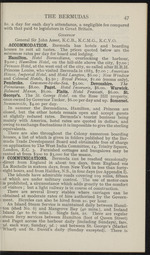 |
“...THE BERMUDAS
47
I 8s. a day for each day’s attendance, a negligible fee compared
[ with that paid to legislators in Great Britain.
Governor
General Sir John Asser, K.C.B., K.C.M.G., K.C.V.O.
ACCOMMODATION1. Bermuda has hotels and boarding
(houses to suit all tastes. The prices quoted below are the
| minimum rates per day for board and lodging.
Hamilton. Hotel Bermudiana, overlooking the harbour,
Ig.oo ; Hamilton Hotel, on the hill-side above the city, $7.00 ;
Princess Hotel, at the west end of the city, so called after H.R.H.
I Princess Louise, who visited Bermuda in 1883, $7.00 ; American
[House, Imperial Hotel, and Hotel Langton, $6.00 ; New Windsor
‘ and Colonial Hotels, $5*5° » Royal Prince, $1.00 (rooms only).
Pembroke. Grasmere-by-the-Sea, f5.00. Devonshire. The
Poincianas. $8.00. Paget. Hotel Inverurie, $6.00. Warwick,
j Belmont Manor, $6.00. Flatts. Hotel Frascati, f 6.00. St.
' George’s. The St. George Hotel, on the Rose Hill property,
I once owned by Governor Tucker, $6.00 per...”
|
|
| 12 |
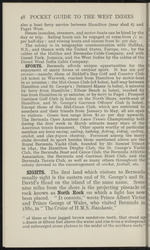 |
“... riding, cycling,
cricket, and clay-pigeon shooting. Foremost among the many
clubs devoted to sport besides those mentioned above are the
Royal Bermuda Yacht Club, founded by Mr. Samuel Triscot
in 1841, the Hamilton Dinghy Club, the St. George’s Yacht
Club, the Bermuda Boat and Canoe Club, the Bermuda Athletic
Association, the Bermuda and Garrison Hunt Club, and the
Bermuda Tennis Club, as well as many others throughout the
colony devoted to the encouragement of cricket, football, etc.
SIGHTS. The first land which visitors to Bermuda
usually sight is the eastern end of St. George’s and St.
David’s Head on the island of the same name. Some
nine miles from the shore is the projecting pinnacle of
rock known as North Bock on which a light has now
been placed. “ It consists,” wrote Prince Albert Victor
and Prince George of Wales, who visited Bermuda in
1880, in The Cruise of H.M.S. Bacchante,”
■
" of three or four jagged brown sandstone teeth, that stand up
a dozen or fifteen feet above the...”
|
|
| 13 |
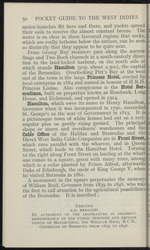 |
“...the wharves, and in Queen
Street, which leads to the Hamilton Hotel. Turning
to the right along Front Street on landing at the wharf
one comes to a square, green with many trees, among
which is a cedar planted by Prince Alfred, afterwards
Duke of Edinburgh, the uncle of King George V, when
he visited Bermuda in 1862.
A monument in the square perpetuates the memory
of William Reid, Governor from 1839 to 1846, who was
the first to call attention to the agricultural possibilities
of the Bermudas. It is inscribed:
ft
Erected
A.D. MDCCCLXI
By authority of the legislature in grateful
REMEMBRANCE OF THE PUBLIC SERVICES AND PRIVATE
worth of Major-Genl. Sir William Reid, K.C.B.,
Governor of Bermuda from 1839 to 1846....”
|
|
| 14 |
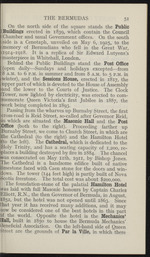 |
“...Jones.
The Cathedral is a handsome edifice built of native
limestone faced with Caen stone for the doors and win-
lows. The tower (144 feet high) is partly built of Nova
Icotia freestone. The total cost was about $200,000.
I The foundation-stone of the palatial Hamilton Hotel
jpas laid with full Masonic honours by Captain Charles
Elliott, R.N., the then Governor of Bermuda, in August,
^852, but the hotel was not opened until 1863. Since
Ihat year it has received many additions, and it may
Aow be considered one of the best hotels in this part
ffj the world. Opposite the hotel is the Mechanics’
Ball, built in 1850 to house the Bermuda Mechanics’
Beneficial Association. On the left-hand side of Queen
ftreet are the grounds of Par la Ville, in which there...”
|
|
| 15 |
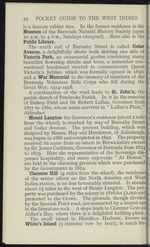 |
“...52 POCKET GUIDE TO THE WEST INDIES
is a famous rubber tree. In the former residence is the
Museum of the Bermuda Natural History Society (open
io a.m. to 4 p.m., Sundays excepted). Here also is the
Public Library.
The north end of Burnaby Street is called Cedar
Avenue, a delightfully shady walk skirting one side of
Victoria Park, an ornamental garden containing many
beautiful flowering shrubs and trees, a somewhat con-
ventional bandstand erected to commemorate Queen
Victoria’s Jubilee, which was formally opened in 1890,
and a War Memorial to the memory of members of the
Bermuda Volunteer Rifle Corps who fell during the.
Great War, 19x4-1918.
A continuation of the road leads to St. John’s, the
parish church of Pembroke Parish. In it lie the remains
of Bishop Field and Sir Robert Laffan, Governor from
1877 to 1882, whose name survives in “ Laffan’s Plain,”
Aldershot.
Mount Langton the Governor’s residence (about 1 mile
from the wharf), is reached by way of Burnaby Street
and Cedar Avenue...”
|
|
| 16 |
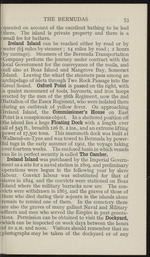 |
“...miles by road; 2 hours
(by carriage). Steamers of the Bermuda Transportation
«Company perform the journey under contract with the
local Government for the conveyance of the mails, and
{call also at Boaz Island and Mangrove Bay, Somerset
I Island. Leaving the wharf the steamers pass among an
archipelago of islets through Two Rock Passage into the
{Great Sound. Oxford Point is passed on the right, with
sa quaint monument of tools, bayonets, and iron hoops
(erected by the men of the 56th Regiment, now the 2nd
I Battalion of the Essex Regiment, who were isolated there
’during an outbreak of yellow fever. On approaching
[Ireland Island, the Commissioner’s House on East
i Point is a conspicuous obj ect. In a sheltered position off
ithe island lies a huge Floating Dock with a length over
1 all of 545 ft., breadth 126 ft. 2 ins., and an extreme lifting
power of 17,500 tons. This mammoth dock was built at
fWallsend-on-Tyne and was towed to Bermuda by power-
jful tugs in the early summer of 1902, the...”
|
|
| 17 |
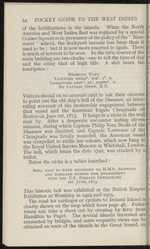 |
“...54 POCKET GUIDE TO THE WEST INDIES
of the fortifications in the islands. When the North
America and West Indies fleet was replaced by a special
Cruiser Squadron in pursuance of the policy of the “ Blue*
water ” school, the dockyard became less busy than it
used to be ; but it is now more resorted to again. There
is much of interest to be seen. In the twin towers of the
main building are two clocks—one to tell the time of day
and the other that of high tide. A slab bears the
inscription:
Bermuda Yard
Latitude xxxii°. xix'. i". n.
Longitude lxiv°. u'. xxxvi'. w.
By Captain Owen, R.N.
Visitors should on no account omit to ask their cicerone
to point out the old ship’s bell óf the Shannon, an inter-
esting souvenir of the memorable engagement between
that vessei and the American frigate Chesapeake off
Boston on June ist, 18x3. It hangs in a niche m the wall
near by. After a desperate encoimter lasting eleven
minutes, during which Captain Philip Vere Broke of the
Shannon was disabled, and Captain...”
|
|
| 18 |
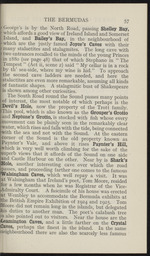 |
“...very well worth climbing for the sake of the
superb views that it affords of the Sound on one side '
and Castle Harbour on the other. Near by is Shark’s
Hole, another interesting cave over which the road
■èse^s, and proceeding farther one comes to the famous
■valsingham Caves, which well repay a visit. It was
itWalsingham that Ireland’s poet, Tom Moore, resided
Pr a few months when he was Registrar of the Vice-
■dmiralty Court. A fascimile of his house was erected
K Wembley to accommodate the Bermuda exhibits at
the British Empire Exhibition of 1924 and 1925. Tom
lloore did not remain long in the islands, but delegated
Ks duties to another man. The poet’s calabash tree
is also pointed out to visitors. Near the house are the
ieamington Caves, and a little farther on the Crystal
Paves, perhaps the finest in the island. In the same
Neighbourhood there are also the scarcely less famous...”
|
|
| 19 |
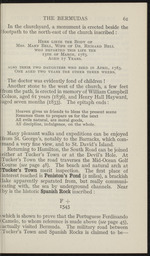 |
“...Town the road traverses the Mid-Ocean Golf
jCourse (see page 48). The beach and natural arch at
I Tucker’s Town merit inspection. The first place of
interest reached is Peniston’s Pond (2 miles), a brackish
lake apparently separated from, but, really communi-
icating with, the sea by underground channels. Near
;by is the historic Spanish Rock inscribed :
F +
1543
H which is shown to prove that the Portuguese Ferdinando
(jCamelo, to whom reference is made above (see page 45),
.factually visited Bermuda. The military road between
"Tucker’s Town and Spanish Rocks is claimed to be—...”
|
|
| 20 |
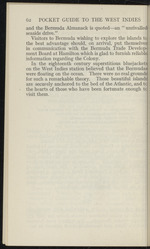 |
“...i
62 POCKET GUIDE TO THE WEST INDIES
and the Bermuda Almanack is quoted—an “ unrivalled
seaside drive."
Visitors to Bermuda wishing to explore the islands to
the best advantage should, on arrival, put themselves
in communication with the Bermuda Trade Develop-
ment Board at Hamilton which is glad to furnish reliable
information regarding the Colony.
In the eighteenth century superstitious bluejackets
on the West Indies station believed that the Bermudas
were floating on the ocean. There were no real grounds
for such a remarkable theory. Those beautiful islands
are securely anchored to the bed of the Atlantic, and tc
the hearts of those who have been fortunate enough tc
visit them....”
|
|
